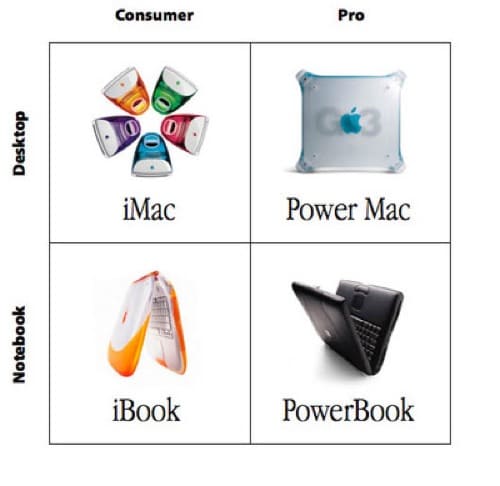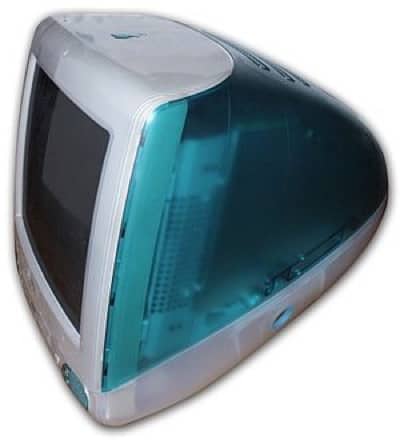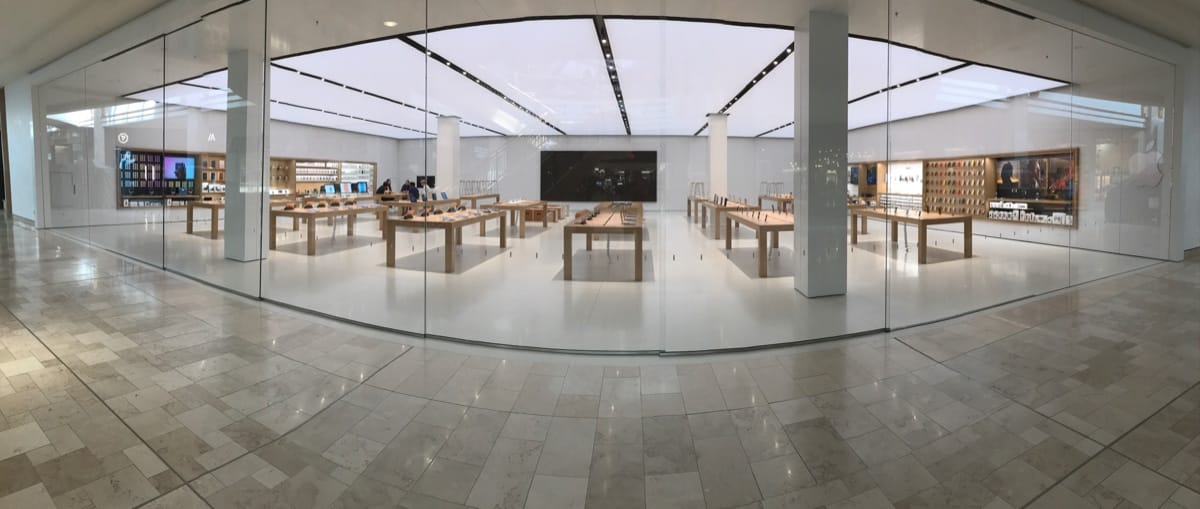Some might insist that Apple’s product line has become bloated. Actually, it’s perfect.
Twenty years ago, Apple was faltering. It’s too many Mac products were poorly designed and picking the right one from a myriad of models was confusing. Steve Jobs realized, correctly, that Apple needed to focus on a few brilliant products that were compelling to the customer.
He created the now legendary 2 x 2 product matrix. Here it is.

Ever since then, for twenty years, Apple’s product line has been growing. And for twenty years, some have longed for the simplicity of that uncomplicated matrix.
And so, the modern question is this: is Apple’s product lineup too complex?
- Why is the MacBook Air still shipping amidst the superior MacBook?
- Why does Apple need a headless, 2018 Mac Pro?
- Why are there so many iPhone models, both current generation and the reduced-priced older generations?
I could go on, but that’s the gist of it.
Size Matters
When Steve Jobs created that basic product matrix, Apple was floundering. Just making payroll was dicey. Bankruptcy was looming. Apple has to come up with a blockbuster piece of hardware, designed by his “A” team, a new Mac, that would blow our socks off. And that’s what Apple did. In August, 1998, Apple introduced the Bondi blue iMac designed by Jonathan Ive. It was smooth, warm, easy to handle, drop-dead gorgeous. And easy to get on the internet. Back then, merely doing that was a hassle.

That iMac, and its brethren in the matrix, saved Apple. Engineers could focus on the Next Great Version of a few products instead of having their efforts diluted amongst many projects. And fiefdoms.
Does that apply today? I would arge that it doesn’t. Apple is roughly forty times bigger now, in revenue, than it was in 1998. It’s customer base has expanded from Macs only into iPhones, iPads, music, audio products, wearables, television and services.
The scope of Apple’s customers has changed. Apple went from being a boutique UNIX computer company to a consumer electronics powerhouse.
Sure, there are products that Tim Cook has said “No” to, following the path of Steve Jobs.
But Apple has also found out, like all consumer electronics companies, that if you leave significant gaps in the product lineup, the competition will move in hard and fast. Growth is threatened.
Apple has discovered that as it has taken the iPhone global. Price-points, colors and features don’t fit uniformly across international boundaries.
Apple discovered that when it allowed the 2013 Mac Pro to linger, dying on the vine whilst HP and Microsoft saw an opportunity to steal technical and creative professionals. And even if Apple doesn’t sell a lot of Mac Pros, that model serves as a halo Mac, a line in the sand, a statement about Apple’s willingness to compete for the hearts and minds of the pros who select their own displays.
Apple discovered that the sleek MacBook fell flat when it came to education. Its advanced, single USB-C port was just too exotic for students looking for an affordable but quality notebook that spoke to them in UNIX-speak. So long as students and educators keep buying the MacBook Air, Apple will ship it.
By The Numbers
Apple not only looks at sales numbers, but it also looks at the varying needs of its spectrum of users. To be sure, if it can’t do something well, it’s wise to disengage. But a company of Apple’s size means that it must engage customers in as many ways as practical or risk losing them in the heat of competition. Growth is at stake.
And so, given the success of Apple, its staggering revenues, profits, and market cap, there’s a case to be made that Apple’s product line is as simple as it can be, but no simpler.

Suppose for the sake of argument that I work in STEM (science, technology, engineering or math). I want the ability to run my workload on a Unix core, while still being able to do the publication and presentation aspects of my work in polished graphical OS. In other words, I want the Mac OS, and I’d like to put it on Apple hardware, because I have had very good lifespan of the hardware I have owned over the years-which translates into a solid return on my time and my money invested in my computer system. My workload doesn’t need graphics, but it does need at least a quad-core processor, and the ability to run that processor at its rated maximum for more than a few minutes. The screen resolution is largely irrelevant, in fact headless is better. Sad to say, there is a giant hole in Apple’s product line right where my use case falls, there are NO headless Macs with quad-core processors. You can’t reduce the price of the least expensive Mac Pro by stripping out one of the graphics processors. You can’t take the minimal screen iMac and bump the processor to a quad-core. You can find a Mac mini from 2012 used that sells for the SAME PRICE as it sold for new. If that doesn’t indicate a hole, I don’t know what does.
While the money people at Apple are mining the small portable electronics market for gold, they need to be asking how those cutting edge technologies get developed and refined in the first place. And the answer is, by hand, by early stage researchers with an idea and no funding, working to computationally model a system or crunch the data from a cobbled together experiment, trying to prove an idea is valid enough to be funded. A very large portion of the computational and material technologies that underpin the iPhones and Apple Watches started with just such an unproven idea.
One definition for Perfect is: Free from any flaw or defect in condition or quality. My headline would read: Apple’s Product Line is Complex. And it’s Perfectly _ ; )
John:
Just a quick reaction to this. Two things.
First, Apple 2018 is not the Apple that SJ inherited when he returned in 1997. And, by the way, neither is the world of 2018 in which Apple have to compete the same as that of 1997. Only in hindsight, and through the retrospectoscope, can we appreciate that, however tumultuous and dire for Apple, those were simpler times in 1997.
SJ’s grid should be seen in the context of Apple’s growth plan, which the company have been following ever since. Apple’s growth, and the elaboration of their platform, I have argued and continue to argue, is organic, and reflects a dynamic interplay of company and client-base over not simply product use but desired product feature set and capability. To be sure, the path has not been linear and without discontinuity, the unexpected and the imperfect. Welcome to organic growth. Those who argue that we have departed from SJ’s four-way grid, as if it were holy scripture, fail, in my opinion, to appreciate the nature of organic growth and Apple’s path to the present. It would be as if someone were to look at the elaboration of a fertilised egg into a blastocyst, when you first get cellular differentiation and say, ‘Aha! So we need different kinds of cells to do different things. Perfect!’ and then sees those differentiated cells morph into an embryo, complete with neural tube and limb buds and cries, ‘This is getting too complicated! I want to go back to simple cellular differentiation!’. You think this is complicated? Wait until we get the foetus and we’re only just getting started (or in French, ‘you ain’t seen nothin’ yet’).
Product differentiation is only a conceptual beginning, a foundation. The challenge lies in the elaboration of complexity whilst still being true to a basic plan, or template. In organic beings, this is achieved by DNA. The same holds for a company; whose DNA is not deoxyribonucleic acid, but an ethos anchored to a core set of organising principles, values and mission. The issue is not complexity, but product and service integration and coherence, which in turn inform function and identity that can distinguish that entity from its environment, including its competitors. This is how DNA not only elaborates our growth but enshrines our distinction and uniqueness. If that DNA further endows us with fitness, that means it has invested us with adaptability, the capacity to respond to changes in our environment in ways that enable us to survive and favourably compete with others.
Second, this leads to another point; elaboration. As things become more complex in an adaptable organism, you get options across functionality. The more challenging and complex the environment, the more options become advantageous. Choice is always good, but even more so in challenging times. The task, for a fit organism or species over time, to remain competitive is efficiency; being able to determine when it is time to winnow those options or features, or for a company, products and services, to that least essential set that still confers a competitive advantage.
The American market of Apple’s birth has changed. More importantly, that market is dynamic, and represents a dwindling share of the global market in which Apple not only have to compete, but thrive. Not only will not every product be targeted to that North American market, as adoption of those products increases in their respective markets, they will take on a larger share of Apple’s overall product output. That’s the beauty of complexity; it’s not zero sum when it comes to options. A product that is designed for an Asian market will find uptake in North America; but so too will products designed for North America find uptake in Asia. More importantly, the dynamic interplay between Apple and those markets will influence product development across the board that should benefit all markets. In time, as those disparate markets begin to coalesce around shared desired features, Apple can once again winnow those products that have more of a niche appeal for those that reflect a broader global consensus. Organic growth. Non-linearity.
Ad infinitum.
Apple’s iPhone compare models page is exactly this.
You need to get out more often
Ha Ha!! I live in Hollywood/LA where you’d think the place would be lousy with them – but alas – it was a fad as I see LESS every year. It clearly was NOT the game changer Apple thought it would be – but then Apple is out of touch as evidenced by chronic catch up in AR and AI, EVs, Autonomy on and on…. you have to wonder where the vision went post-Jobs. Has Apple made ANY new product that wasn’t on the board when Jobs passed? I think not. Boatloads of cash makes me wonder what the HELL have they been doing in R&D for the last several years. It took Space X 10 yrs from 1st orbital launch to Falcon Heavy; Tesla’s 1st car the Roadster came out 10 years ago – convincing the ENTIRE automotive scene to sea change mostly because of Elon and Tesla/SolarCity….But Apple does what? 🎬
I see a lot of people wearing them. The Apple Watch table in the stores are busy with buyers and upgraders.
I double down on my advice to get out more often. 😀
Product line is “Perfect”? Glad to see the Kool-Aid is still around. Yep- it’s perfect – I’ve been driving my Apple Car for months and my Apple EV Bicycle with iOS integrated dash display gets me all over town – the solar cell infused frame with my Apple BackPak Solar Battery rig gets me all over town without charging – and the supreme Apple AI does all the nav/steering and braking for me…in fact Apple’s AR and AI is so good that unlike Siri if you ask it when the great SF earthquake of 1906 was, it won’t steer you to a bunch of earthquake sites on the web instead of answering the question… I heard somewhere that Apple even made another Watch – but I thinkthat was a rumor because I never see anybody wearing Apple watches. But I will wear mine proudly once in a while – never needs charging – and it runs backwards because it “thinks different”… oh, and the wonderful Mac Pro line….
Old UNIX Guy: But the 2013 Mac Pro was used as an example, an aberration that Apple is on track to fix. I should think, for the Mac Pro, perfection is an ongoing process. ::gulp::
John, beyond the fact that no one and nothing is perfect, you’re just plain wrong to claim that Apple’s current product lineup is even close to perfect.
For just one example, Apple doesn’t sell a Pro laptop (other than the possible exception of the almost 3 year old 2015 15″ MBP that they still will sell you … at full price). Now, I know that they claim that they do, but we all – you included – know that they don’t.
You yourself brought up the joke that is the 2013 Mac Pro.
So how is that a “perfect” lineup?
Normally I agree with you John, but not on this one…
Old UNIX Guy
My main gripe with Apple isn’t with hardware it’s siri. Sometimes it works great sometimes it’s awful. I think Apple let this technology wither and with all its know how and resources it’s a bit embarrassing. So pick up your game Apple you can do better. C+
I am in a rather interesting love/hate relationship with Siri. Dr Phil, wouldn’t touch it, but we are scheduled to be on the Jerry Springer Show.
Well I have never heard or read anyone complain about Apple’s Mac Product line up being complex. None. When anyone who does complain about complicated line up mostly refers to iPhone, and rightly so.
And when people do complain about the Mac, it is about their product, not the line up.